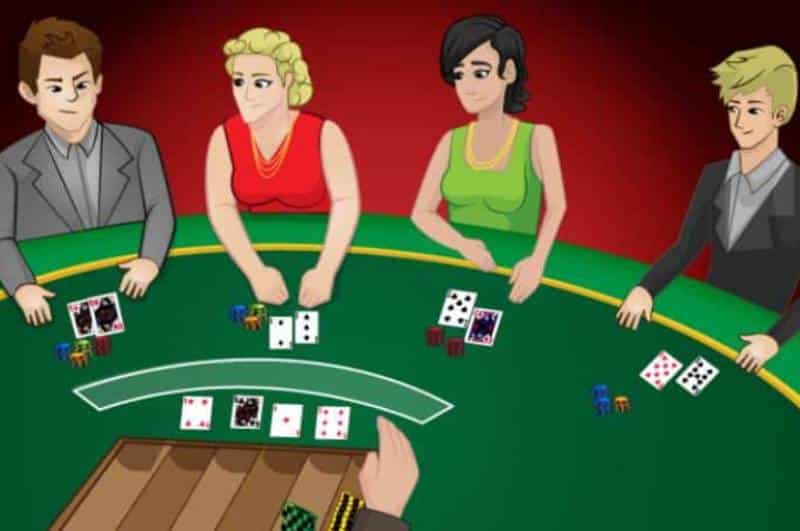What is Shuffle Tracking in Blackjack?
I’ll bet you a dollar that you’ve heard of basic playing strategy and card counting in blackjack. However, I’ll bet the ranch that shuffle tracking isn’t the case. This is about to change.

Theory of Shuffle Tracking
A casino dealer cannot randomly shuffle four or more decks of cards in a reasonable amount of time. Shuffle trackers keep track of where clumps (or zones) of high cards are placed in the discard tray when they see a lot of tens and aces on the felt during a round of play.
They then watch where the cards end up after the shuffle, cut the zone to the top of the shuffled stack of cards and bet big when it’s time to deal.
When to Surrender in Blackjack
What’s Involved?
Here’s an example of a shuffle tracker’s technique for keeping track of unplayed cards in a six-deck shoe game.
Assume a shuffle tracker is counting cards in a six-deck game and, after four and a half decks, the cut (or shuffle) card comes out of the shoe. Assume he has a very positive count right now. The latter tells him that the clump of unplayed cards behind the cut card must have a high concentration of tens and aces.
He carefully tracks this clump through the dealer’s shuffling procedure so that he can predict where this clump of high cards is in the freshly shuffled stack of cards with a high degree of certainty. The cut card is then placed directly above this clump or zone of high cards, ending at the top of the stack of cards.
The dealer knows that the first zone of cards that will be dealt from the shoe contains an excess of high cards after placing the shuffled stack into the dealing shoe. As a result, he will place large bets at the start of the round (and usually play multiple spots).
OK, now that you have a general understanding of shuffle tracking, let’s get into the specifics of what a shuffle tracker must learn and do to succeed at this skill.
- He must be familiar with the shuffling routine used by casino dealers.
- To know where the high-card zone ends after the shuffle, he must simulate it at home. This is referred to as “mapping the shuffle.”
- He must direct the cut card’s placement in the shuffled stack of cards.
Casinos’ Shuffling Routine
Casinos use several different types of shuffling procedures. Here’s an example from the late Vinny DeCarlo, a casino dealer and floor supervisor who also worked in casino surveillance and was an expert card counter.
“The dealer takes the cards from the discard tray and arranges them in three piles on the layout.” She begins the shuffling process by selecting a pile (grab) from pile one (far left) and a pile (grab) from pile three (far right). She joins these two grabs by riffling them at least twice, then adding a strip (i.e., peeling off the top cards of a grab and sending them to the bottom of the grab/stack), followed by another riffle (i.e., the act of joining two grabs together, aka a shuffle). She then riffles a deck’s worth of cards from the middle pile with the new stack. Then it’s random grabs and swaps (drawing cards randomly from a full stack of shuffled cards and riffling them together with added strips).”
After reading the above, I’m sure your first thought is that shuffle tracking is impossible. However, this is not the case, even though it is a difficult skill to master. With enough practice, tracking a target zone of cards through shuffling to predict where they will be located in the shuffled stack of cards is possible.
Doing this correctly is to practice and map out the casino’s shuffling procedure at home. There are tools available to assist you. Arnold Snyder, a member of the Blackjack Hall of Fame, wrote the classic book on shuffle tracking, The Blackjack Shuffle Tracker’s Cookbook. In addition, Vinny DeCarlo’s article in the Blackjack Insider newsletter includes a technique for practising mapping with six decks of cards and two different coloured Sharpie Markers.
Shuffle tracking is also covered in Bill Zender’s book, Advantage Play for the Casino Executive. Finally, the well-known Casino Vérité blackjack software program includes a shuffle-tracking module.
Cutting the Shuffled Cards
The key to gaining an advantage in shuffle tracking is to control the cut card so that you cut off everything that isn’t in your ten-rich zone and the first cards out of the shoe are the player-favourable high cards. Playing heads-up against a dealer is a no-brainer to keep control of the cut.
However, when other players are present, it becomes a crapshoot whether they will receive the cut card. Instead, you can ask the player if you can cut by saying something like, “I’m always lucky and win when I cut.” The better solution, and one used by most professional shuffle trackers, is to have a team of players on the table, with one of them controlling the cut.
Playing and Betting
A shuffle tracker who has precisely cut a ten-rich deck to the top of the shuffled stack of cards will place a large bet on the first round. He frequently plays multiple spots with large bets and keeps placing large bets until the ten-rich zone is depleted. To take advantage of the 10-rich zone, he will also employ a modified hitting, standing, doubling down, and pair splitting strategy.
Pros of Shuffle Tracking
- Shuffle trackers can gain far more advantages than card counters.
- Making large bets right after the shuffle is excellent camouflage because card counters usually have to wait until several decks have been played before increasing their bets.
- Bet spreads can be much wider than what a card counter can accept.
Cons of Shuffle Tracking
- You must be a skilled card counter.
- It is far more difficult to learn than card counting. Shuffle trackers must be extremely precise in their estimates of where the zone of ten-rich cards is located and their control of the cut card.
- As they begin to track shuffles in the casino, shuffle trackers frequently lose money in the short run. Making errors in determining the precise location of the ten-rich zone can be costly to a shuffle tracker.
- You must find a casino that employs a simple casino shuffling procedure.
- Even if you find a casino with a simple shuffle procedure, it can be changed on the fly.
- Shuffle tracking, unlike card counting, is not an exact science.
Casino Countermeasures
Casinos have not sat idly by since learning about shuffle tracking (and how much shuffle trackers were taking from their coffers). Here are some of the steps they’ve taken to prevent shuffle tracking:
- The dealer will “plug” the unplayed cards into the stack of “played” cards at various random locations.
- They used a more “complicated” shuffling routine to ensure that the dealer mixed the cards randomly in a reasonable amount of time.
- They change their shuffling procedures regularly.
- They installed shuffling machines that were both automatic and continuous.
Camouflage
Large bets on the first round after a shuffle. However, doing it regularly and winning money will attract attention.
Arnold Snyder’s book Radical Blackjack contains the best techniques for concealing the fact that you are shuffle tracking. His wife, Radar, and he won a lot of money at shuffle tracking, and the details of their playing trips, including the camouflage they used, are revealed in his book. If you want to pursue shuffle tracking, this is a must-read.
Card Counting vs. Shuffle Tracking
The table below compares the characteristics of card counting and shuffle tracking.
| Characteristics | Card Counting | Shuffle Tracking |
| Increasing Bets | Rarely after the shuffle | Usually, after the shuffle |
| Number of Decks of Cards | 1, 2, 4, 6, or 8 | 6 or 8 |
| Bet Spread Six-Deck Game | 1 to 12 | Can be much greater than 1-12 |
| Level of Difficulty | Moderate | Very High |
| Team Play | Yes | Yes |
| Precision in Strategy Implementation | Low-Medium | Very High |
| Per cent Advantage | 0.5% – 1.5% | Can be much greater than 1.5% |
| Exact Science | Yes | No |
Online Blackjack Games
Sorry, but you can’t shuffle track a blackjack game in an online casino because the cards are shuffled after each round by a random number generator.
Other Cards to Track
In addition to tracking ten-rich zones, shuffle trackers occasionally track low-card-rich zones and remove them from play. Ace sequencing is a technique similar to shuffle tracking in which a player watches where the aces go into the discard tray, follows them through the shuffle, and controls the cut so that the ace is the first card dealt from a shoe.
Summary
- A technique that detects when slugs of high cards are inserted in counting before learning and using shuffle tracking task of cards. Trackers follow this zone through the shuffle, allowing you to see where it ends up in the shuffled stack of cards.
- A shuffle tracker must then control the placement of the cut card so that he can predict when this zone will be dealt from the shoe.
- He then fires away with large bets in a ten-rich zone, gaining a significant advantage over the casino.
- This skill takes a lot of practice and works best with a group of players.
- Shuffle tracking is ineffective with automatic or continuous shufflers, as well as in online blackjack games.
- It works best when a casino employs a straightforward manual casino shuffling procedure.
- A player must be proficient in basic playing strategy and card counting before learning and using shuffle tracking.
100% up to €500 or 5 BTC





